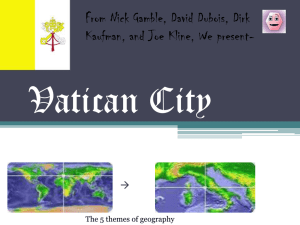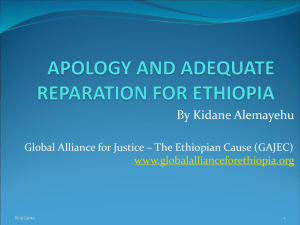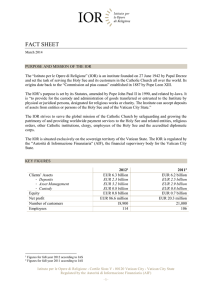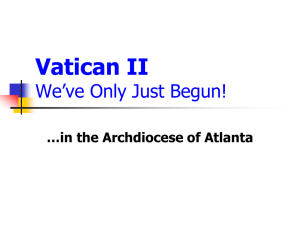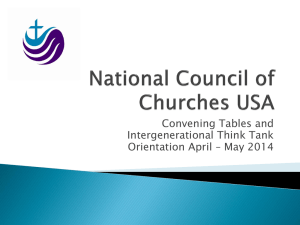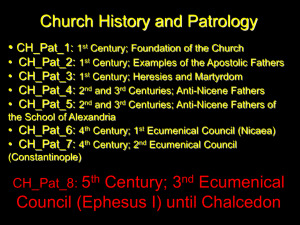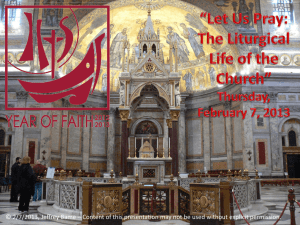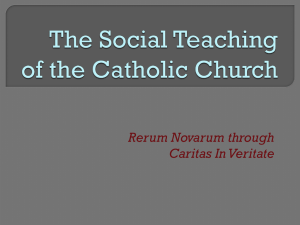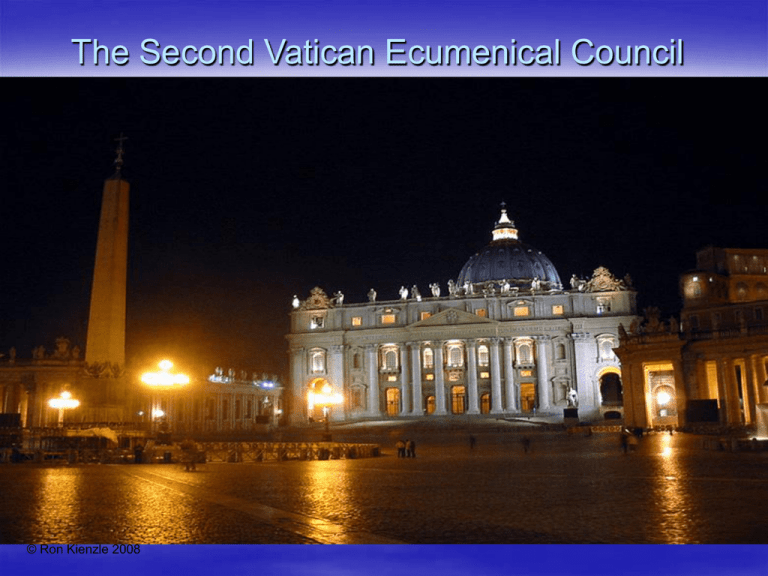
The Second Vatican Ecumenical Council
© Ron Kienzle 2008
The Second Vatican Ecumenical Council
Was it…
The best thing that ever happened to the Church?
Or
The worst thing that ever happened to the Church?
© Ron Kienzle 2008
The Second Vatican Ecumenical Council
The critics (“defenders”) say that Vatican II:
–Was led, not by the Holy Spirit, but by Satan
–The Liturgy became corrupt and profane
The music was an abomination
Eucharistic prayers are unscriptural and wrong
Attendance at Mass declined
–Numbers of priests and religious declined
–Pastoral Authority was undermined and eroded
–Teachings are ambiguous
–Morals have eroded
–Missionary activity is confused and unorganized
–Dissent is rampant
–Sex scandals a result of lax confused teachings
© Ron Kienzle 2008
The Second Vatican Ecumenical Council
There should not be women at the altar
There should be no altar girls
The vernacular Lexionary is suspect
Respect and reverence for the Most Holy
Eucharist is lost when taken standing and in
the hand
© Ron Kienzle 2008
The Second Vatican Ecumenical Council
Sacred Liturgy is not as the Apostles
intended; Religious Freedom is a
contradiction; All dogmas, morality, and
practices are ridiculous and contradictory
--Marcel Lefebvre
“…The sheep suffer for what the shepherds
do wrong and as a result we have been
wandering in a spiritual desert of liberal
theology for the past 40 years.”
--Robert Sungenis
© Ron Kienzle 2008
The Second Vatican Ecumenical Council
Supporters (“progressives”) say that V.II:
Reenergized the Church and made it more relevant
Empowered women and laity in service to the Church
–Liturgical ministers
–Parish councils and other advisory groups
–Parish administrators
–Diaconate
Emphasized marriage as a vocation of relationship
Annulment process was made better
Attention to society and the poor increased vastly
© Ron Kienzle 2008
The Second Vatican Ecumenical Council
“Without Vatican II I couldn’t have remained faithful to the
Church or its teachings.”
“The Liturgy has been opened up to us and now we can
participate more fully and pray more efficaciously.”
“I could never have converted to Catholicism before
Vatican II.”
“I understand the Mass now.”
“Faith is no longer a formula or rote memorization but an
internalization of intellectual, emotional, spiritual
understanding”
© Ron Kienzle 2008
The Second Vatican Ecumenical Council
There have been 21 Ecumenical Councils
(Ecumenical = world wide)
The last three councils were
Council of Trent (1545 – 1563) #19
First Vatican Council (1869 – 1870) #20
Second Vatican Council (1962 – 1965) #21
© Ron Kienzle 2008
The Second Vatican Ecumenical Council
Background History
19th Ecumenical Council: Council of Trent
–1545 – 1563 (18 years!)
–Pope Pius V (1556 – 1572)
–Tridentine Missal (Tridentine = “of Trent”)
–Tridentine Catechism (In US “Baltimore”)
–Sacred music was canonized
–The Church begins isolationism
Response to Luther and other reformers (1517
forward)
Henry VIII (1534)
Failed inquisitions
Final East/West Schism (1484)
Persecutions of Roman Catholics
© Ron Kienzle 2008
The Second Vatican Ecumenical Council
Pope Pius V –
portrait by El Greco
© Ron Kienzle 2008
The Second Vatican Ecumenical Council
More Background History
•20th Council was Vatican I
–Summoned by Pius IX (1846 – 1878)
–1869 – 1870
–Interrupted by Franco-Prussian war
–First act of V.II was to adjourn V.I
–Reaffirmation of the Word of God (Bible)
–Reaffirmation of the primacy and infallibility
of the Pope
•Pius IX – Immaculate Conception (1854)
•Pius XII – Assumption of Mary (1950)
© Ron Kienzle 2008
The Second Vatican Ecumenical Council
© Ron Kienzle 2008
The Second Vatican Ecumenical Council
Why was the 21st Council necessary?
Dozens of technological advances changed the very
way we think
Improved communication highlighted global problems
(have vs. have-not nations)
Atheism became popular
Cold war, Communism, Humanism
Continuing Protestant “reformation”
Church became rigid and authoritarian
Beatnik revolution
Women’s issues began to surface
© Ron Kienzle 2008
The Second Vatican Ecumenical Council
© Ron Kienzle 2008
The Second Vatican Ecumenical Council
Just in America!
•Beatniks
•Timothy Leary
•Playboy Magazine
•Explosive growth of
Evangelicals
•Sputnik and the rise of
science
© Ron Kienzle 2008
The Second Vatican Ecumenical Council
Why was V.II NOT necessary?
Attendance at Mass was high
Abundance of priests and religious
Schools flourished
Catholic education thought to be best in
nation
Liturgy was beautiful and holy
The members understood the hierarchy and
were faithful to it
© Ron Kienzle 2008
The Second Vatican Ecumenical Council
•Pope John XXIII
(1958 – 1963)
announces the Council
in 1959
•Oversaw the opening
session the fall of 1962
•Died June 1963
© Ron Kienzle 2008
The Second Vatican Ecumenical Council
Pope Paul VI (19631978) continued the
council
–Sessions began in
September of each year
1963 thru 1965 ending
in late November or
early December each
year
© Ron Kienzle 2008
The Second Vatican Ecumenical Council
Attendance by “Council Fathers” varied
from 2500+ to about 2100
Mostly bishops and heads of male
religious orders
Many other groups were represented:
–There were over 17 Orthodox representatives
–A large number of Protestants
–23 Catholic women “auditors” – 3 from US
–All these groups contributed to discussions
© Ron Kienzle 2008
The Second Vatican Ecumenical Council
What were the results?
16 Documents
No changes to dogma
© Ron Kienzle 2008
The Second Vatican Ecumenical Council
Four Constitutions:
Lumen Gentium (Light of Nations) – Dogmatic
Constitution on the Church
Dei Verbum (Word of God) – Dogmatic Constitution
on Divine Revelation
Sacrosanctum Concilium (Sacred Council) –
Dogmatic Constitution on the Sacred Liturgy
Gaudium et Spes (Joys and Hopes) – Dogmatic
Constitution on the Church in the Modern World
© Ron Kienzle 2008
The Second Vatican Ecumenical Council
Three Declarations:
Gravissimum Educationis (Paramount Importance of
Education)– Declaration on Christian Education
Nostra Aetate (In Our Day) – Declaration on our
Relationship to Non-Christian Religions
Dignitatis Humanae (The Dignity of the Human
Person) – Right of the Person and Communities to
Social and Civil Freedom in Matters Religious
© Ron Kienzle 2008
The Second Vatican Ecumenical Council
9 Decrees
Ad Gentes Divinitus (Sent by God to the Nations)–
Mission Activity of the Church
Presbyterorum Ordinus (The Order of Priests) –
Ministry and Life of Priests
Apostolicam Acuositatem (To Intensify the
Apostalate) – Apostolate of the Laity
Optatam Totius (Desired of the Whole Church) –
Training of Priests
Perfectae Caritatis (Perfect Charity) – Up-to-Date
Renewal of Religious Life
© Ron Kienzle 2008
The Second Vatican Ecumenical Council
9 Decrees (continued)
Christus Dominus (Christ the Lord) – Decree
on the Pastoral Office of Bishops in the
Church
Unitas Redintegratio (The Restoration of
Unity) – Decree on Ecumenism
Orientalium Ecclesiarum (Churches of the
Orient) – Decree on the Catholic Eastern
Churches
Inter Mirifica (Among the Wonderful) –
Decree on the Mass Media
© Ron Kienzle 2008
The Second Vatican Ecumenical Council
Lumen Gentium
Dei Verbum
Sacrosanctum Concilium
Gaudium et Spes
Apostolicam Acuositatem
© Ron Kienzle 2008
The Second Vatican Ecumenical Council
Lumen Gentium
The hub document
The Mystery of the Church
–Membership includes Christ’s followers and those
who have died in union with Christ – Mary, the
Saints in Heaven and the souls in Purgatory
–It is a union of the divine and the human
The people of God are the foundation
–Hierarchy exists as the trained ordained ministers
of God who stand for the apostles
–Pope is still the head of the Church (Peter)
© Ron Kienzle 2008
The Second Vatican Ecumenical Council
Lumen Gentium (continued)
Emphasis on the marks of the Church:
–One Holy Catholic Apostolic
–If one knows that “The Catholic Church was made
necessary by God through Jesus Christ [and] would
refuse to enter her or to remain in her [he/she]
could not be saved.”
–The council builds on tradition and does not
conflict with it
© Ron Kienzle 2008
The Second Vatican Ecumenical Council
Lumen Gentium (continued)
Preservation of the divine deposit of faith is
of prime importance
Provisions are made for the Diaconate
Mary is given special honor
–The Blessed Virgin is a model of faithful
discipleship – she is a member of the Church,
Mother of the Church and mediatrix (warning:
don’t get extreme)
© Ron Kienzle 2008
The Second Vatican Ecumenical Council
Lumen Gentium (continued)
NOTHING in this or any of the documents teaches:
Optional Mass attendance & reception of the
sacraments
Abortion, divorce, gay marriage, married clergy
Not reading scripture and seek holiness
Non-submission to the pope
Subjective religious truth
That all religions are equally valid
© Ron Kienzle 2008
The Second Vatican Ecumenical Council
Dei Verbum
God invites us into a personal relationship
with Him
Through Sacred Scripture we come to
know God with “ease, with solid certitude,
and with no trace of error.”
The Bible is “the Word of God in human
words”
© Ron Kienzle 2008
The Second Vatican Ecumenical Council
Dei Verbum (continued)
“The Church, in her teaching life, and
worship, perpetuates and hands on to all
generations all that she herself is, all that she
believes” (Sacred Tradition)
Sacred Tradition grows and becomes richer
as our leaders, guided by the Holy Spirit, lead
to a deeper and fuller understanding of the
truth.
Nothing in Sacred Tradition can contradict
Sacred Scripture
© Ron Kienzle 2008
The Second Vatican Ecumenical Council
Dei Verbum (continued)
Christians should read the Bible
and are urged to use modern
methods of interpretation
© Ron Kienzle 2008
The Second Vatican Ecumenical Council
Gaudium et Spes
Man is inherently good and dignified – we
are created by God
Christ died to save each and every
individual human being
We are given free will but sin reduces our
options
Christians should not judge persons but
their actions
© Ron Kienzle 2008
The Second Vatican Ecumenical Council
Gaudium et Spes (continued)
Rights of each person
–Everything necessary for leading a life truly
human; e.g., food, clothing, shelter
–To choose a state of life and to found a family
–An education, employment, good reputation
–Respect
–Appropriate information
–Protection of privacy
–Freedom in matters of religion
–Special rights of women
© Ron Kienzle 2008
The Second Vatican Ecumenical Council
Gaudium et Spes (continued)
Denunciations
Any opposition to life
(abortion, euthanasia, murder)
All forms of slavery
Prostitution
Pornography
© Ron Kienzle 2008
The Second Vatican Ecumenical Council
Apostolicam Actuositatem
Apostolate = to carry on the mission of Christ
First ecumenical document on the laity
Vatican II often called “the council of the laity”
The laity are members of God’s “Royal
Priesthood” and thus offer “priestly sacrifices”
in their daily lives, witness, and words
Lay people are in the world not just Church
–Unique social justice in service to the poor, etc.
© Ron Kienzle 2008
The Second Vatican Ecumenical Council
Apostolicam Actuositatem (continued)
Vatican II attempts to renew zeal and
love
–We should be nourished in the
Liturgy
–Gifts of the Holy Spirit are to be
manifested for the common good
–Bishops must develop lay
ministries and services and systems
to train lay ministers (caution:
ordained clergy are still the
authorities)
© Ron Kienzle 2008
The Second Vatican Ecumenical Council
Sacrosanctum Concilium
The
summit of all Church activity is the
Liturgy
Only in worship do all our good works make
sense
All our sacrifices [for family, for others, for
God] are offered to God the Father with the
Lord’s body
We get access to the fountain of grace that
flows from the font of the Cross of Jesus
Christ
The Church exists primarily to worship God
© Ron Kienzle 2008
The Second Vatican Ecumenical Council
Sacrosanctum Concilium (continued)
BUT, it is possible to participate in the Liturgy
without living out its grace and teaching in
everyday life
•We
must come to the Mass with the proper
disposition
•We must follow through with prayer
•We must fully and consciously participate in
the Liturgy
© Ron Kienzle 2008
The Second Vatican Ecumenical Council
Sacrosanctum Concilium (continued)
•Streamline by “Noble Simplicity”
•Avoid needless repetition
•Respect people’s power of comprehension
•Emphasize Holy Scripture and promote love for
the word of God
•Conduct the Liturgy in the language of the
people
•Restore the Catechumenate (RCIA)
•Open up the Church for all peoples everywhere
•End the isolationism of the past 400 years
© Ron Kienzle 2008
The Second Vatican Ecumenical Council
Sacrosanctum Concilium (continued)
•Increase
involvement by the laity
•Introduce prayers to increase
participation such as “Prayer of the
Faithful”
•Replace Extreme Unction with Anointing
of the Sick
•Renew directions for Sacred Music, art,
and furnishings
© Ron Kienzle 2008
The Second Vatican Ecumenical Council
Sacrosanctum Concilium (continued)
Emphasize the real
presence of Christ in
the Eucharist
(Sometimes we forget how special we are)
© Ron Kienzle 2008
The Second Vatican Ecumenical Council
© Ron Kienzle 2008
The Second Vatican Ecumenical Council
For your consideration:
Were bishops and priests too zealous in
their adoption of Vatican II changes?
Was the “plan” adequate?
Did the laity take extreme liberties?
Was there sufficient apologia about the
changes?
Did some expect more out of Vatican II?
© Ron Kienzle 2008
The Second Vatican Ecumenical Council
Was it…
The best thing that ever
happened to the Church?
Or
The worst thing that ever
happened to the Church?
© Ron Kienzle 2008
The Second Vatican Ecumenical Council
Two Books every Catholic family should own
© Ron Kienzle 2008
The Second Vatican Ecumenical Council
Bibliography
Flannery, Austin, O.P., The Basic Sixteen Documents of Vatican
Council II (Newport, NY, Costello Publishing Company, Inc., 1996)
Shreck, Alan, Vatican II: The Crisis and the Promise (Cincinnati,
Servant Books, 2005)
McEnroy, Carmel, Guests in Their Own House (NY, Crossroad
Publishing Co., 1996)
Davies, Michael, Liturgical Time Bombs in Vatican II (Rockford, IL,
Tan Books & Publishers, Inc., 2003)
McBride, Alfred, A short History of the Mass (Cincinnati, St.
Anthony Messenger Press, 2006)
Vatican II Productions, The Faithful Revolution: Vatican II (Lyrick
Studios, distributor, 1997) 5 volume video series
Koch, Carl, A Popular History of the Catholic Church (Winona, MN,
Saint Mary’s Press, 1997)
Chaput, Charles J., Render Unto Caesar (NY, Doubleday, 2008)
© Ron Kienzle 2008
The Second Vatican Ecumenical Council
www.st-jerome-cinci.org/VaticanII
© Ron Kienzle 2008

